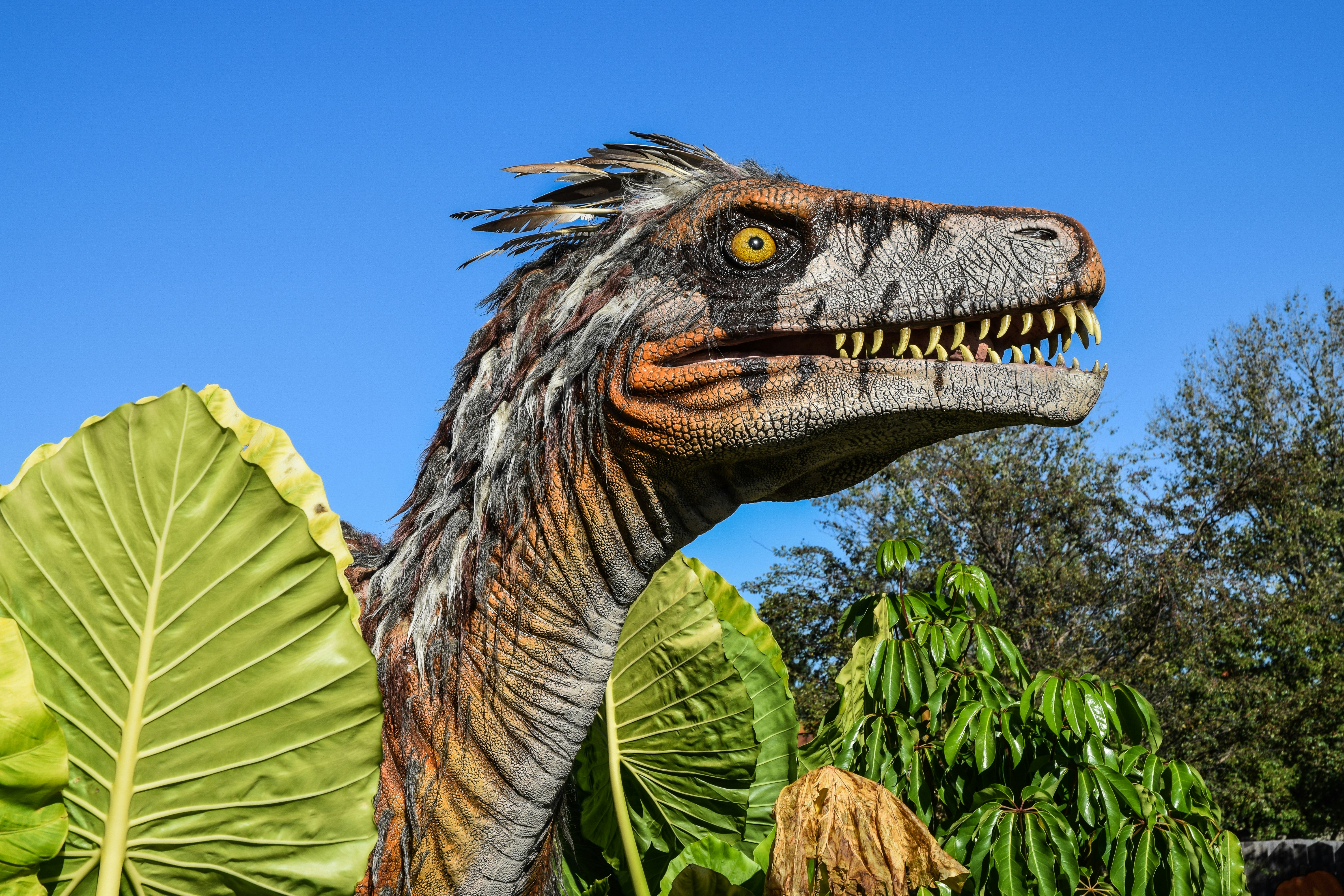Dragon Feathers
The dracling nipped at the tufts of down feathers on its shoulder. Strands of the hair-like feathers snagged on its needle teeth.
Kneeling before the tiny creature, Ruth flipped through her notes to “Flynt Dragons.” Was the dracling sick? Did the little fella have fleas? Ticks? “Flynt dragons are born with a healthy layer of down feathers when they first hatch,” she read. “This provides an insulating layer for the young dragons that keeps their body thermoregulated during the early months of spring at high elevations.”
More puffs of feather settled to the ground. Ruth frantically turned the pages. Should she stop this or not?
“Once the hatchling grows to the dracling stage, however, they develop harder scales, making their protective down coat unnecessary. Most draclings shed the down by rubbing against the rocks near their roost. However, some draclings take a more direct approach, choosing to pluck out their own plume.”
The dracling interrupted her research by proudly placing a mouthful of dragon down onto the page. It clicked expectantly up at Ruth, eager for her to accept its once-shoulder cover.
Ruth held up her gift. “Thank you, I think?” The dracling hopped on its claws, whistling with glee. “Oh, that’s—” The dracling’s snout went to its other shoulder and ripped out another mouthful of down to drop into Ruth’s book. “…Adorable.” Ruth watched the dracling proceed to prune itself of all shoulder and arm feathers. “Gotta be honest little fella; I’m struggling to decide if eagerly giving me parts of your body is cute or slightly disturbing.”
More Dragons!
Around the “are dragons birds or reptiles” discourse (see my last dragon post), the question of whether or not dragons had feathers arose. I of course spread this question across my social media to pick my readers’ brains.
Unlike the previous question, which had very distinct sides, everyone seemed to immediately come to a consensus on this one: some dragons would be feathered.
This surprised me. I can’t think of any major fantasy series sporting dragons that has any feathered dragons. Game of Thrones, Dragonriders of Pern, Eragorn, Temeraire, How to Train Your Dragon, Enchanted Forest Chronicles, Dragonlance, and even the dragon-rider-romantasy-that-shall-not-be-named* all have scaley dragons. I did find one book from 1993 named “Dragon Feathers” By Andrei Dugin that seemed to deviate from this trend, but I had never heard of this book until I did some digging.
*No, you will not get me to say the title. I refuse. This book haunts me wherever I go.
A quick search on Wikipedia shows that there is a mythical creature called the Amphiptere that is winged, serpent-like, and feathered, but it’s not what I would call a “dragon.”
And yet, responses seemed accepting of feather-clad dragons without any pushback. To say I was excited is an understatement. It means feather dragons have a place in fantasy; we need to fill that gap now… with science!
Feather’s Tickling Our Fancy

Before we go too deep into feathery dragons, we need to look at the biological wonder that is “feathers.”
So, what are feathers?
A silly, but necessary question. A dive into some science articles tells me that they’re… “corneous microramifications.” For a simpler definition, let’s turn to Wikipedia: “epidermal growths.” So, things that grow out of your outermost skin layer. Feathers are made up of a protein called “keratin,” specifically β-keratin. This specific keratin is found in both reptiles and birds (which makes sense, considering that they’re evolutionarily related to one another; see my previous post.) β-keratin is much harder than the α-keratin found in mammalian fingernails and hair.
I know that I said that β-keratin exists in both reptilian scales and avian feathers, but there is a distinct difference. Scale keratin is larger than feather keratin; because their derivative genes are so similar, though, this article suggests that the feather keratin may have evolved from the scale keratin due to a deletion in the gene.
Why is this distinction important? Well, besides being evidence for feathers evolving from scales, they’ve also found that in embryonic alligators, both scale and feather-keratin can be found (though the feather-keratin is lost by the time the alligator develops into an adult, but the important part is that the alligator, at one point, makes the feather-keratin).
Dino Plumage

Let’s slide from the alligator to our favorite extinct animal, the dinosaur.
You may know that feathers were a feature for some dinosaurs. While not all dinosaurs had a layer of feathers, many bipedal dinosaurs had feathers… though not necessarily avian feathers (more on that later).
Why would dinosaurs evolve feathers if most couldn’t use them for flights? Well, as Daniel Ksepka puts it, feathers can “form airfoils… elaborate display structures… serve to camouflage and insulate, to generate and help detect sound, and even to disintegrate into powder to condition other feathers.” Feathers can also make a creature more aerodynamic, or act as a waterproof layer for the animal (β-keratin in the feathers allows them to be waterproof). Feathers are a biological advantage that we flightless mammals may be missing out on!
Now, I did say that the feathers of dinosaurs were “non avian” or non-bird feathers. I’ve even seen some of the dinosaur feathers described as “proto-feathers” (see this link again). This paper here examined the distinction of these types of feathers and found that non-avian dinosaur feathers had a mix of both β-keratin and α-keratin, unlike the feathers of modern birds that have predominantly β-keratin. Remember, α-keratin is the softer keratin that we find more in mammalian hair and fingernails. While most dinosaur feathers weren’t the best for flight, they still effectively protected the dinos from the environment.
Bringing It Back To Dragons
We’ve talked a lot about feathers, we’ve talked about dinos, but let’s go to the real star of the show: dragons.
Would dragons have feathers?
Whether your dragons are related to birds or reptiles, your dragons can still have the capacity to develop feathers. Even the crocodile has feather-keratin during its early life stage.
If your dragons fly, I think they would, or at least some species would. If you recall from my last dragon post, dragons could be exposed to temperatures as low as -65.81°F during their flights. As feathers can act as amazing insulators (especially compared to scales and hair), I think it evolutionary beneficial to have some natural chill protection.
Would these feathers help in flight? Hard to say; your dragons could be covered in those proto-feathers mentioned earlier, while using classic draconic wings to fly. Or, they could be all bird and have massive swan-like wings.
Can you imagine how adorable newly-hatched dragons would look if they’re covered in down feathers like chicks? Would it be a type of feather that poachers hunt for, leading to groups protecting dragon caves and territories? Would dragon feathers be a luxury item for your fantasy cultures, or are they a nuisance that you can find all over the place?
If dragons have feathers, would that mean they have a type of down feather called pulviplumes? If so, that means that those feathers will degrade into dust, which means “dragon dust” would be around dragon nests or roosts.
For my worldbuilding, I’d have my cake and eat it too: I’d have both scaled and feathered dragons. Spice up the dragons a little! Imagine nobles who ride scaled dragons and also sleep in dragon-down mattresses. Maybe the scaled dragons are actually domesticated and were bred to have scales because they’re better for war (for natural protection), while the wild dragons of the world are actually feathered.
Takeaways
Oh, these dragon posts are so much fun! The biological ramifications of feathered dragons are vast, but the cultural implications? Feathers have always been used in cultures around the world; imagine how dragon feathers would be used. No doubt they would be used as status symbols, but could they be used for quills? Or are there draconic feathers so big that you could use them like a broom or an umbrella?
For plots, we could have characters protecting dragons from illegal plume hunting. We could have a world suffering the aftermath of draconic plume hunting, where people are working to bring back endangered hunted dragons. The history of plume hunting has so much plot potential authors can mine for.
Or, you could go into the domestication of dragons to select for scales, as mentioned above. You could go into how dragon riders are trying to breed scaled dragons from feathered in order to keep up with the technological advancement in weapons (which would be a super complex story, the more I think about it).
Not that we’re getting rid of scaled dragons—we’d never dream of it—, but with feathered dragons? The novel world building and plot possibilities are endless, not to mention the badass artist renditions that could arise from this one change! Excuse me while I go write up a quick draft of a “protect a feathery dragon” short story; happy writing!
